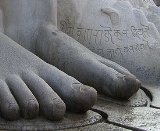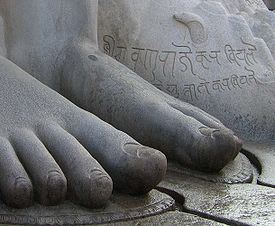
Mula Sangh
Encyclopedia
Mula Sangh is an ancient Jain monastic order . Mula literally means the "root" or the original order.
Mula-Sangh has been the main Digambar Jain order. Today the Digambar Jain tradition is synonymous with Mula Sangha. The great Acharya Kundakunda
is associated with Mula Sangh. The oldest known mention of Mula Sangh is from 430 AD.
Mula Sangh was divided into a few branches. According to Shrutavatara of Acharya
Indranandi and Nitisar of Bhattaraka
Indranandi, Acharya Arhadbali had organized a council of Jain monks, and had given names (gana or sangha) to different groups. The four major groups were

The Bhattaraka
s of Shravanabelagola
and Mudabidri belong to Deshiya Gana, the Bhattaraka of Humbaj
belongs to the Balatkara Gana.
Several Digambara orders in North India belonged to Kashtha Sangha. There were some minor differences in practices between the Mula Sangh and the Kashtha Sangh.
Mula-Sangh has been the main Digambar Jain order. Today the Digambar Jain tradition is synonymous with Mula Sangha. The great Acharya Kundakunda
Kundakunda
Kundakunda is a celebrated Jain Acharya, Jain scholar monk, 2nd century CE, composer of spiritual classics such as: Samayasara, Niyamasara, Pancastikayasara, Pravacanasara, Atthapahuda and Barasanuvekkha. He occupies the highest place in the tradition of the Jain acharyas.He belonged to the Mula...
is associated with Mula Sangh. The oldest known mention of Mula Sangh is from 430 AD.
Mula Sangh was divided into a few branches. According to Shrutavatara of Acharya
Acharya
In Indian religions and society, an acharya is a guide or instructor in religious matters; founder, or leader of a sect; or a highly learned man or a title affixed to the names of learned men...
Indranandi and Nitisar of Bhattaraka
Bhattaraka
A Bhaṭṭāraka is the head of traditional Jain institutions. They are responsible for training of scholars, maintenance of libraries, managing the endowments, presiding over the installation ceremonies and running of Jain institutions....
Indranandi, Acharya Arhadbali had organized a council of Jain monks, and had given names (gana or sangha) to different groups. The four major groups were

- Nandi Gana, which had two major lineages:
- Balatkara GanaBalatkara GanaBalatkara Gana is an ancient Jain monastic order. It is a section of the Mula Sangh. It is often termed Balatkara Gana Sarasvati Gachchha....
, Saraswati Gachchha (oldest known mention 1071 AD) - Deshiya Gana, Pustaka Gachchha (oldest known mention 860 AD)
- Balatkara Gana
- Sena Gana, the lineage of JinasenaJinasenaJinasena is the name of several famous Jain Acharyas of the Digambar tradition.* The author of Harivamsha Purana in the 8th century. He belonged to the Punnata branch of Jain monks....
it was formerly called Panchastupa or Surastha. (oldest known mention 821 AD) - Deva Gana, the lineage of Akalanka deva
- Simha Gana
The Bhattaraka
Bhattaraka
A Bhaṭṭāraka is the head of traditional Jain institutions. They are responsible for training of scholars, maintenance of libraries, managing the endowments, presiding over the installation ceremonies and running of Jain institutions....
s of Shravanabelagola
Shravanabelagola
Shravana Belgola is a city located in the Hassan district in the Indian state of Karnataka and is 158 km from Bangalore. The statue of Gommateshvara Bahubali at Śravaṇa Beḷgoḷa is one of the most important pilgrimage destinations in Jainism, one that reached a peak in architectural and sculptural...
and Mudabidri belong to Deshiya Gana, the Bhattaraka of Humbaj
Humbaj
Humbaj is a small village located in Shimoga district in the Indian state of Karnataka. It is famous for being home to an ancient temple of Goddess Padmavati, and to the Humbaj Matha , an important institution of the Jain community...
belongs to the Balatkara Gana.
Several Digambara orders in North India belonged to Kashtha Sangha. There were some minor differences in practices between the Mula Sangh and the Kashtha Sangh.

